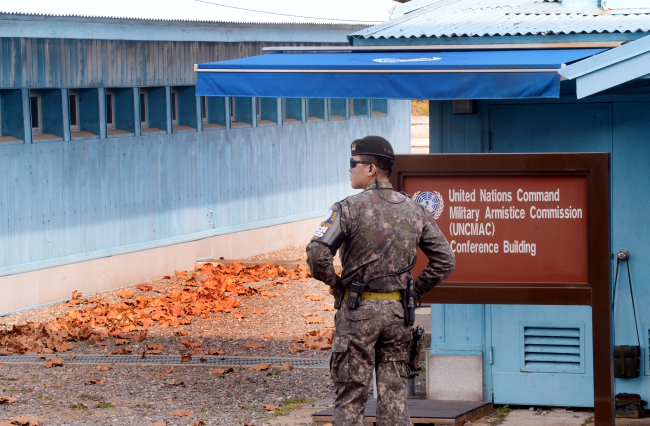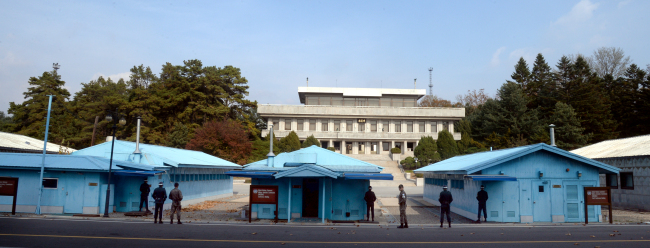The North Korean soldier who dashed across the border to defect is a 20-something noncommissioned officer who had served at the Joint Security Area in the heavily fortified Demilitarized Zone, South Korea’s spy agency said Thursday.
Four of the soldier’s former comrades chased him toward the Demilitarized Zone, the de facto border between the two Koreas. They shot at him about 40 times. It is unclear whether they continued to shoot after the solider crossed the Military Demarcation Line and entered the territory controlled by the United Nations Command.
When he was found under a pile of leaves south of the MDL, he was unarmed and wearing a Korean People’s Army Uniform. He was also bloodied from gunshots to his shoulder, elbow and abdomen. He was rescued by South Korean soldiers and transported to a local hospital.
“His rank amounts to staff sergeant,” the National Intelligence Service was quoted as saying by Rep. Kim Byung-kee, who attended the closed-door meeting. “Regarding his personal belongings, we didn’t find anything special.”

Joint Security Area. Park Hyun-koo/The Korea Herald
The wounded soldier, whose identity and motive for defection have not been revealed, has shown signs of “stabilization,” but is still in critical condition, according to doctor Lee Cook-jong who performed surgeries on him.
Meanwhile, a scheduled plan to release detailed footage of the defection was scrapped by the UNC, which withdrew the decision at the last minute. It was initially scheduled to reveal the footage in the afternoon, but delayed the decision.
The 26-second footage reportedly shows chasing guards firing shots -- including those from AK-47 assault rifles -- at the fleeing soldier. It also reportedly captured him crouching down and staggering toward the Military Demarcation Line.
According to the UNC, the decision to reveal the image rests on its Commander Gen. Vincent K. Brooks, who doubles as the commander of United States Forces in South Korea and the US-led Combined Forces Command.
The presidential office Cheong Wa Dae, meanwhile, said South Korea has no authority to change the rules of engagement applied to the JSA amid controversy over its soldiers’ decision not to return fire at the North Korean soldiers who were chasing the defecting soldier.
When asked if South Korea would seek to change the engagement rules applied to the JSA by adopting its own version, Cheong Wa Dae said Seoul does not “have a say” in the matter because the authority falls under the US-led United Nations Command, which assumes operational control of the JSA.
“We could raise our opinion, but we have no authority to change the rules,” the official told reporters under the customary condition of anonymity. “It’s under the authority of the UNC. The Defense Ministry doesn’t have a say in the matter.”

Joint Security Area. Park Hyun-koo/The Korea Herald
The remark came after a report that the Defense Ministry is seeking to consult with the UNC to apply South Korea’s own rules of engagement to the JSA when North Korea poses a direct threat to South Korean soldiers as they did during the incident Monday.
Although the South Korean Army took over the duty of keeping security inside the JSA from the US in 2004, the authority over the use of force falls under UNC commander Gen. Vincent K. Brooks.
The official also downplayed a remark by President Moon Jae-in, who told his presidential staff that a change to the rules of engagement is “worthy of discussion” after being briefed about the shooting incident Wednesday.
“It was more like raising his opinion, not issuing an order,” the official said. “He made observations from the perspective of average people. … Now that the president has made remarks, there could be further discussion with the UNC.
President Moon said that if North Korea fires its bullets across the border, the general public expects the rules of engagement to require South Korean soldiers to at least fire “warning shots” toward North Korean soldiers.
Located inside the 4-kilometer-wide Demilitarized Zone, the JSA is jointly overseen by the UN Command and by North Korea, with South Korean and North Korean border guards facing each other only meters apart.
Therefore, South Korean soldiers inside the JSA are not allowed to use military force unless their action is justified under the UNC rules of engagement applied to the JSA, according to South Korea’s Joint Chiefs of Staff.
“The UNC commander considers two parts to determine whether such a response is appropriate: whether there is a direct threat to our guards and whether our response would escalate the situation,” JCS chief director of operations Gen. Suh Wook told lawmakers Wednesday.
By Yeo Jun-suk (jasonyeo@heraldcorp.com)







